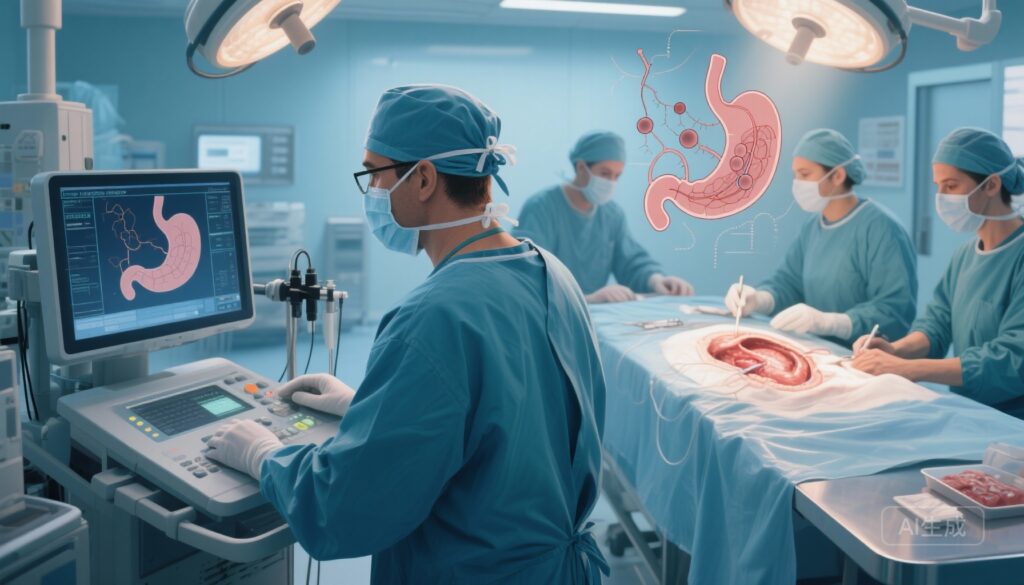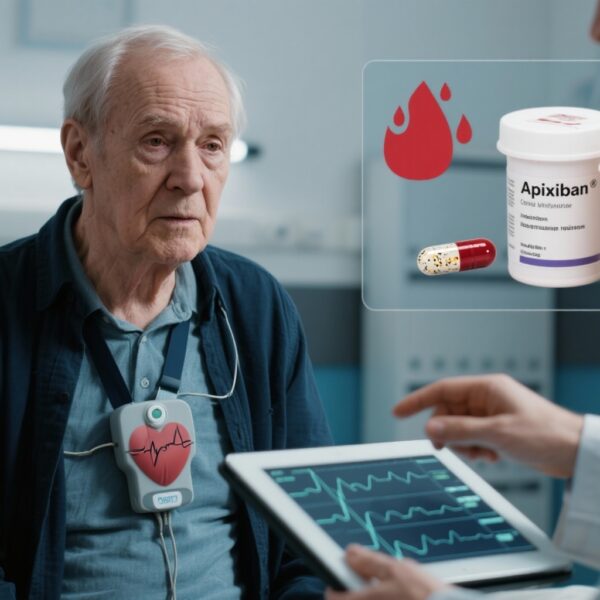Highlights
• The UMC‑UPPERGI‑01 single‑center noninferiority randomized clinical trial randomized 208 patients with clinical T4a gastric cancer to laparoscopic distal gastrectomy (LDG) or open distal gastrectomy (ODG) with D2 lymphadenectomy (104 per arm).
• Thirty‑day postoperative morbidity and mortality were comparable between LDG and ODG (any complication 22.1% vs 21.2%; severe complications 2.9% vs 3.8%).
• LDG required longer operative time (mean 220.0 vs 153.7 minutes) and was associated with higher median blood loss (80 vs 50 mL), but clinical recovery metrics (time to flatus, oral intake, length of stay, time to adjuvant chemotherapy) were similar.
Background
Gastric cancer remains a major global cause of cancer morbidity and mortality. For locally advanced distal gastric cancers that invade the serosa (clinical T4a), curative resection with an adequate lymphadenectomy (D2) is standard in many regions. Minimally invasive surgery (MIS), primarily laparoscopy, has been progressively adopted for earlier stages of gastric cancer because of benefits in pain, convalescence, and equivalent oncologic outcomes in selected populations. However, T4a tumors raise technical concerns about achieving negative margins, completing a thorough D2 dissection, avoiding tumor handling that could increase dissemination risk, and managing potentially adherent or locally invasive disease. Prior randomized data addressed laparoscopic versus open approaches in mixed-stage advanced gastric cancer cohorts, but a prospective trial designed specifically for clinical T4a disease has been lacking. The UMC‑UPPERGI‑01 trial was designed to fill that evidence gap by comparing short‑term surgical outcomes between LDG and ODG in patients with clinical T4a distal gastric cancer.
Study design
The UMC‑UPPERGI‑01 was a single‑center, open‑label, noninferiority randomized clinical trial conducted at a tertiary hospital in Ho Chi Minh City, Vietnam (ClinicalTrials.gov NCT04384757). Between June 2020 and April 2025, patients with clinical T4a distal gastric cancer and planned curative‑intent distal gastrectomy with D2 lymphadenectomy were randomized 1:1 to receive LDG or ODG. The full analysis set included 208 patients (104 per arm) with no crossovers. Procedures were performed exclusively by qualified surgeons experienced in gastric cancer D2 dissections. Primary reported outcomes for the interim/short‑term analyses included perioperative surgical results, pathological characteristics, 30‑day postoperative morbidity and mortality (Clavien‑Dindo classification), and postoperative recovery parameters. The trial’s noninferiority margin and longer‑term oncologic endpoints will be reported after ongoing follow‑up.
Key findings
Patient characteristics were balanced between groups (mean age ~61 years; 24% female in LDG and 27.9% female in ODG). Key perioperative and 30‑day outcomes included:
Complications and mortality: There were no statistically significant differences in 30‑day postoperative complications or mortality. Any postoperative complication occurred in 22.1% of LDG patients versus 21.2% of ODG patients (P = .87). Severe complications (Clavien‑Dindo grade ≥III) occurred in 2.9% versus 3.8% respectively (P > .99). Surgical complications were numerically similar (21.2% LDG vs 16.4% ODG; P = .37) as were general (medical) complications (3.9% LDG vs 10.6% ODG; P = .11).
Operative metrics: Operative time was substantially longer for LDG (mean 220.0 ± 42.4 minutes) compared with ODG (153.7 ± 36.7 minutes; P < .001). Median intraoperative blood loss was higher in the LDG group (80 mL, IQR 50–145) than in the ODG group (50 mL, IQR 30–100; P = .003). Despite these differences, absolute blood loss in both groups remained modest.
Recovery and oncologic logistics: Measures of immediate recovery—time to first flatus, time to oral tolerance, length of postoperative hospital stay, and time from surgery to initiation of adjuvant chemotherapy—did not differ significantly between LDG and ODG.
Risk factors: Multivariate analysis identified comorbidity as an independent predictor of postoperative complications (odds ratio 2.42; 95% CI, 1.11–5.30; P = .03). The trial report did not indicate procedural crossover, which suggests intraoperative feasibility for LDG in this selected setting.
Pathologic outcomes: The trial report indicates pathological characteristics were collected, but short‑term report details were limited in the summary. Long‑term oncologic outcomes (recurrence patterns, disease‑free and overall survival, R0 resection rates, and lymph node yield) are pending on continued follow‑up.
Expert commentary and interpretation
The UMC‑UPPERGI‑01 trial provides important randomized evidence that, in the hands of qualified surgeons at a high‑volume tertiary center, laparoscopic distal gastrectomy with D2 lymphadenectomy can achieve short‑term safety outcomes comparable to open surgery for clinical T4a gastric cancer. This addresses a key concern among surgeons about the applicability of minimally invasive techniques to serosa‑invasive disease.
Several practical points follow from the findings. First, the increased operative time with LDG is consistent with other complex laparoscopic procedures and is likely attributable to the technical demands of intracorporeal dissection and lymphadenectomy in advanced disease. Second, the higher but still modest blood loss in LDG argues against clear hemostatic inferiority; both approaches had clinically acceptable intraoperative bleeding. Third, equivalent short‑term recovery metrics imply that the minimally invasive approach does not meaningfully shorten early convalescence in this cohort—potential benefits may be marginal when comparing complex LDG and ODG for advanced tumors.
However, the single‑center design and performance by experienced, qualified surgeons limit generalizability. Centers with lower laparoscopic gastric cancer volumes or surgeons earlier on the learning curve may not replicate these results. Because the trial is open‑label, assessment biases for subjective endpoints are possible, although objective complication rates and hard endpoints such as mortality mitigate that concern.
Most importantly, oncologic equivalence remains to be established. For T4a disease, long‑term data on R0 resection rates, lymph node yield, recurrence (local vs peritoneal), disease‑free survival, and overall survival are essential before broadly recommending LDG as an oncologic standard. The absence of crossovers in this report suggests intraoperative selection and feasibility were good in this cohort, but conversion rates and details of handling adherent tumor (e.g., en bloc resections requiring adjacent organ removal) will influence applicability.
From a systems perspective, adoption of LDG for T4a disease would require structured training, proctoring, and institutional support to ensure D2 quality while maintaining oncologic principles.
Limitations
Key limitations of the presented interim/short‑term analysis include its single‑center scope, lack of detailed pathological/oncologic outcome reporting in the short‑term manuscript extract, and potential selection of patients and surgeons that may not reflect broader practice. The noninferiority margin used for the trial primary hypothesis was not provided in the summary; readers should review the full manuscript for statistical design specifics.
Conclusion and clinical implications
The UMC‑UPPERGI‑01 randomized trial demonstrates that laparoscopic distal gastrectomy with D2 lymphadenectomy yields comparable 30‑day morbidity and mortality to open distal gastrectomy for clinical T4a gastric cancer in an experienced center, albeit with longer operative times and slightly greater blood loss. These data support considering LDG as an alternative to open surgery for T4a disease when performed by surgeons with appropriate expertise and institutional support. Careful patient selection, adherence to oncologic principles, and transparent reporting of conversion, margin and lymph node outcomes are essential.
Pending the trial’s long‑term oncologic results and corroboration in multicenter settings, clinicians should discuss the current evidence and trade‑offs (operative time, surgeon experience, unknown long‑term equivalence) with patients when planning resection for T4a distal gastric cancer.
Funding and trial registration
The trial is reported as the UMC‑UPPERGI‑01 randomized clinical trial. Trial registration: ClinicalTrials.gov Identifier: NCT04384757. Funding details and full protocol are available in the primary publication.
Reference
Dat TQ, Thong DQ, Nguyen DT, Hai NV, Phuoc TD, Anh NVT, Bac NH, Long VD. Laparoscopic vs Open Distal Gastrectomy With D2 Lymphadenectomy for Clinical T4a Gastric Cancer: The UMC‑UPPERGI‑01 Randomized Clinical Trial. JAMA Surg. 2025 Nov 12:e254929. doi: 10.1001/jamasurg.2025.4929. Epub ahead of print. PMID: 41222957; PMCID: PMC12613089.



